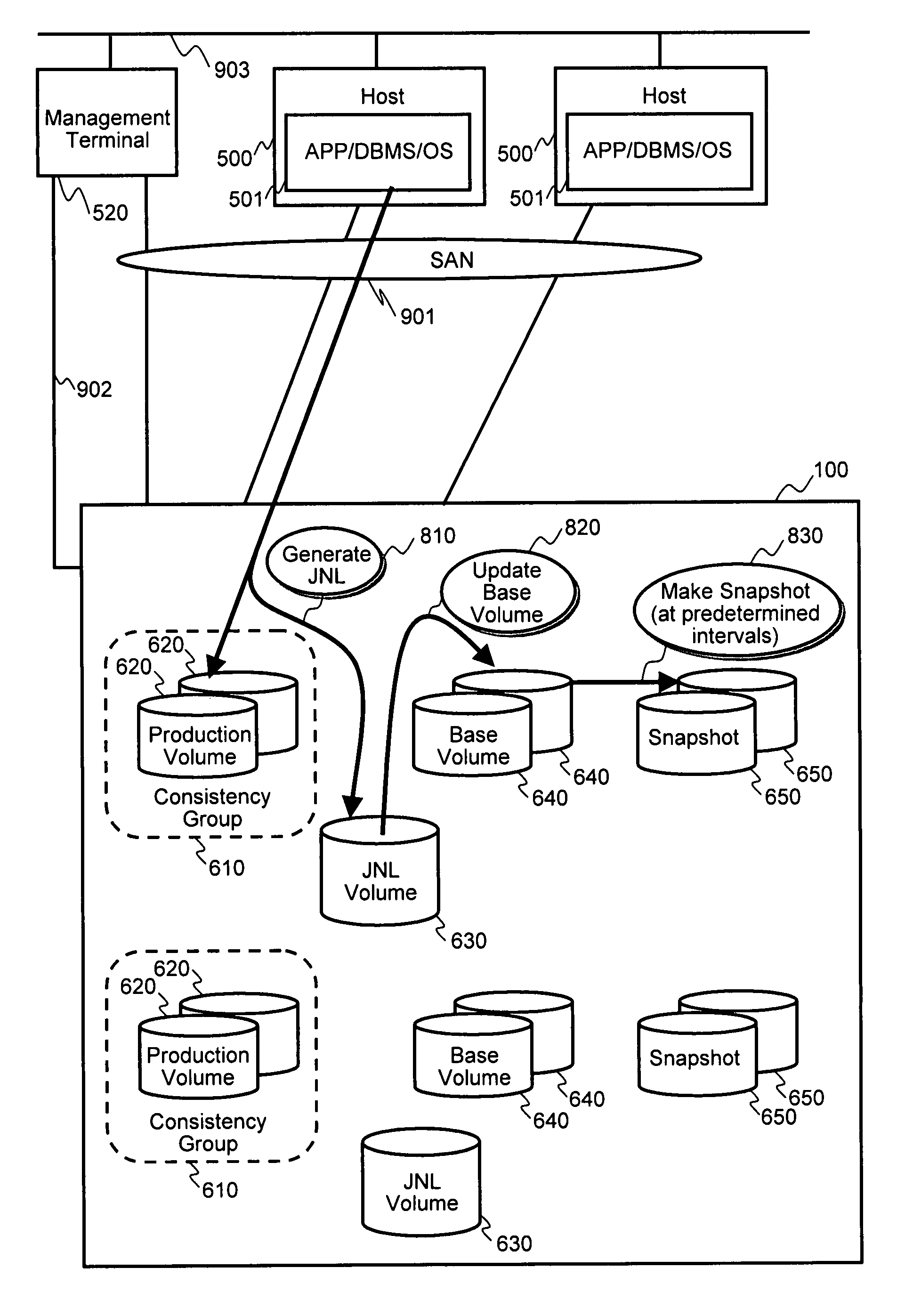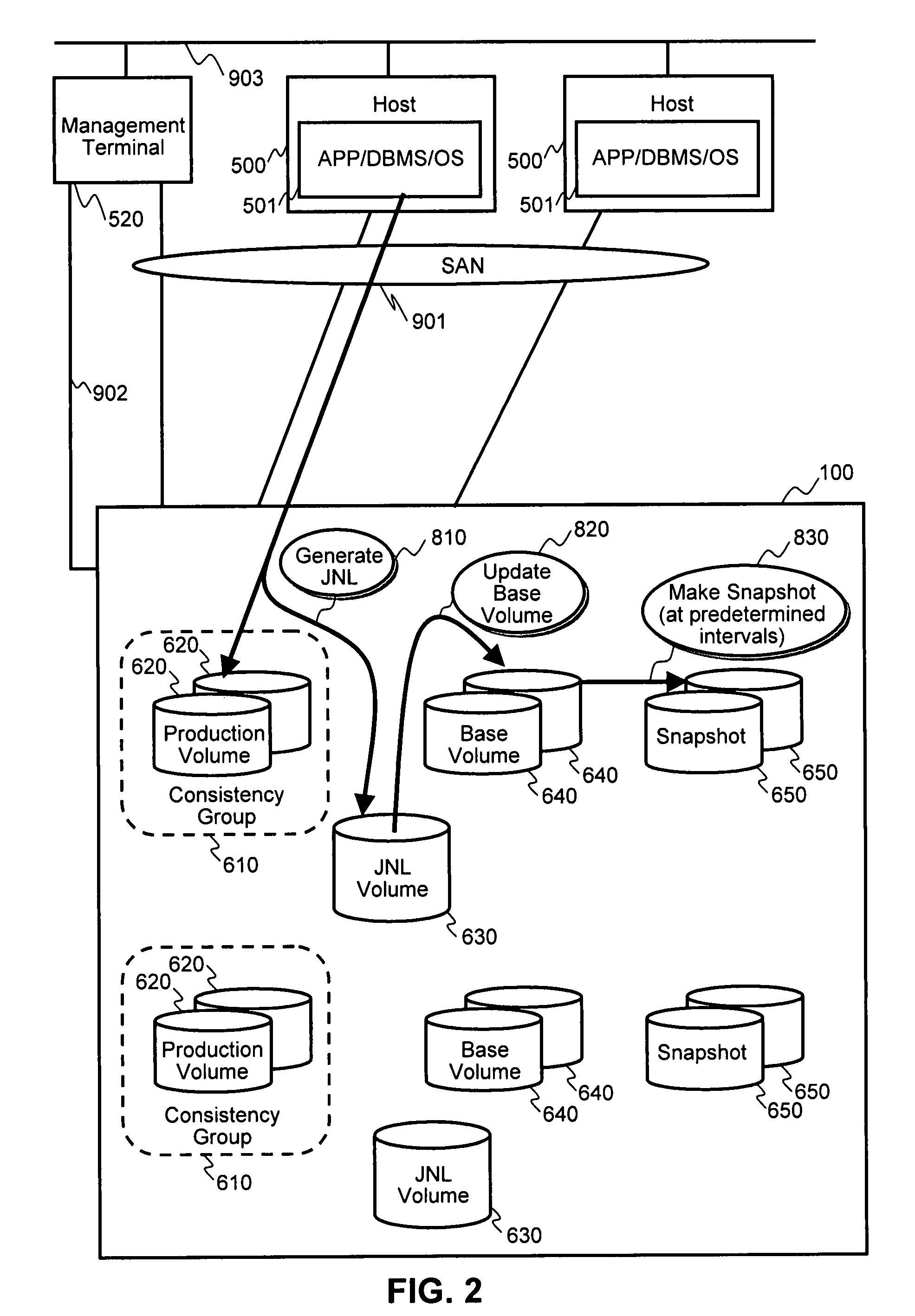Methods and apparatus for adjusting a journal area for continuous data protection
a journal area and data protection technology, applied in the field of storage systems and data backup and recovery, can solve the problems of restoring the image of data, affecting the accuracy of data recovery,
- Summary
- Abstract
- Description
- Claims
- Application Information
AI Technical Summary
Benefits of technology
Problems solved by technology
Method used
Image
Examples
first embodiments
[0038]FIG. 1 describes and exemplary system and hardware configuration of an information system under which first embodiments of the invention may be practiced. A storage system 100 includes an array controller 110 for receiving data access commands from one or more host computers 500 via a network 901. Network 901 may be a storage area network (SAN), such as a Fibre Channel network, iSCSI(IP) or other network type or communications link enabling communications between hosts 500 and storage system 100.
[0039]Array controller 110 may include a main processor 111, a switch 112, one or more host interface (I / F) controllers 113, a system memory 200, a cache memory 300, and one or more disk controllers 400. Disk controllers 400 couple array controller 110 to one or more hard disk drives (HDDs) 600 via a backend path 601. Back end path 601 may be Fibre Channel, SATA, SAS, iSCSI(IP), or other suitable type of connection.
[0040]Main processor 111 performs various processes in array control...
second embodiments
on
[0082]FIG. 14 illustrates the system configuration of the second embodiments. The differences from the configuration of the first embodiments are that memory 200 includes chunk mapping information 205 and chunk usage information 206. In this configuration, storage areas provided by disks 600 are divided into a number of fixed-length storage area (i.e. chunks 690), and volumes (logical units) including journal volumes 630 are provided by allocating chunks of storage on demand. Moreover, in the second embodiments, as illustrated in FIG. 15, consistency group information 201 includes an additional preservation period field 2016, which retains information on a specified preservation period for journal data, as is discussed further below.
[0083]FIG. 16 illustrates a manner to provide volumes 602 in the storage system 100 of the second embodiment. In FIG. 16, a journal volume 630 is constituted by multiple segments 692 virtually, and one chunk 690 is assigned to one segment 692 as physic...
third embodiments
ting Journal
[0118]FIG. 23 illustrates a process of generating a journal in the third embodiments. The system configuration of the third embodiments may be the same as described above for the second embodiments. In the third embodiments, journal entries are able to be stored across chunks, such that a portion of a journal entry may be stored in a first chunk, and the remainder of the journal entry may be stored in a second chunk, thereby reducing wasted storage capacity. The process includes steps 1601-1609, as described below.
[0119]At step 1601, host 500 issues a write request and transfers write data to array controller 110.
[0120]At step 1602, array controller 110 stores the write data in production volume 620 according to the write request.
[0121]At step 1603, array controller 110 checks the remaining unused capacity (length) of the current chunk for containing metadata and the remaining unused capacity of the current chunk for containing journal data.
[0122]At step 1604, as a resul...
PUM
 Login to View More
Login to View More Abstract
Description
Claims
Application Information
 Login to View More
Login to View More - R&D
- Intellectual Property
- Life Sciences
- Materials
- Tech Scout
- Unparalleled Data Quality
- Higher Quality Content
- 60% Fewer Hallucinations
Browse by: Latest US Patents, China's latest patents, Technical Efficacy Thesaurus, Application Domain, Technology Topic, Popular Technical Reports.
© 2025 PatSnap. All rights reserved.Legal|Privacy policy|Modern Slavery Act Transparency Statement|Sitemap|About US| Contact US: help@patsnap.com



